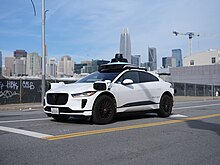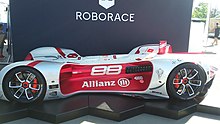
Back مركبة ذاتية القيادة Arabic Özügedən avtomobil Azerbaijani Автономен автомобил Bulgarian རང་འགུལ་ངང་རླངས་འཁོར་གཏོང་བ། Tibetan Vehicle autònom Catalan Autonomní vozidlo Czech Car diyrrwr Welsh Førerløs bil Danish Selbstfahrendes Kraftfahrzeug German Senŝofora aŭto Esperanto
| Part of a series on |
| Self-driving cars & self-driving vehicles |
|---|
 |
| Enablers |
| Topics |
| Related topics |
A self-driving car, also known as an autonomous car (AC), driverless car, robotaxi, robotic car or robo-car,[1][2][3] is a car that is capable of operating with reduced or no human input.[4][5] Self-driving cars are responsible for all driving activities, such as perceiving the environment, monitoring important systems, and controlling the vehicle, which includes navigating from origin to destination.[6]
ACs have the potential to impact the automotive industry, mobility costs, health, welfare, urban planning, traffic, insurance, labor markets, and other domains. Appropriate regulations are necessary to integrate ACs into the existing driving environment.
Multiple vendors are pursuing autonomy, but as of early 2024, no system has achieved full autonomy. Waymo was the first to offer rides in self-driving taxis to the public,[7] and as of April 2024[update] offers services in Arizona (Phoenix) and California (San Francisco and Los Angeles). Cruise offered taxi service in San Francisco,[8] but suspended service in 2023. In 2021, Honda was the first manufacturer to sell an SAE Level 3 car,[9][10][11] followed by Mercedes-Benz in 2023.[12] Baidu started offering robotaxi service in China in 2023. Other companies include DeepRoute.ai and Pony.ai.
 |
 |
- ^ Taeihagh, Araz; Lim, Hazel Si Min (2 January 2019). "Governing autonomous vehicles: emerging responses for safety, liability, privacy, cybersecurity, and industry risks". Transport Reviews. 39 (1): 103–128. arXiv:1807.05720. doi:10.1080/01441647.2018.1494640. ISSN 0144-1647. S2CID 49862783.
- ^ Maki, Sydney; Sage, Alexandria (19 March 2018). "Self-driving Uber car kills Arizona woman crossing street". Reuters. Retrieved 14 April 2019.
- ^ Thrun, Sebastian (2010). "Toward Robotic Cars". Communications of the ACM. 53 (4): 99–106. doi:10.1145/1721654.1721679. S2CID 207177792.
- ^ Xie, S.; Hu, J.; Bhowmick, P.; Ding, Z.; Arvin, F. (2022). "Distributed Motion Planning for Safe Autonomous Vehicle Overtaking via Artificial Potential Field". IEEE Transactions on Intelligent Transportation Systems. 23 (11): 21531–21547. doi:10.1109/TITS.2022.3189741. S2CID 250588120. Retrieved 2 February 2024.
{{cite journal}}: CS1 maint: multiple names: authors list (link) - ^ Gehrig, Stefan K.; Stein, Fridtjof J. (1999). Dead reckoning and cartography using stereo vision for an automated car. IEEE/RSJ International Conference on Intelligent Robots and Systems. Vol. 3. Kyongju. pp. 1507–1512. doi:10.1109/IROS.1999.811692. ISBN 0-7803-5184-3.
- ^ Xie, S.; Hu, J.; Ding, Z.; Arvin, F. (2023). "Cooperative Adaptive Cruise Control for Connected Autonomous Vehicles Using Spring Damping Energy Model". IEEE Transactions on Vehicular Technology. 72 (3): 2974–2987. doi:10.1109/TVT.2022.3218575. S2CID 253359200. Retrieved 1 February 2024.
- ^ "Waymo's Robotaxis are Hitting the Highway, A First For Self Driving Cars". Forbes.
- ^ Vijayenthiran, Viknesh (2 February 2022). "Cruise opens up driverless taxi service to public in San Francisco". Motor Authority. Retrieved 27 March 2022.
- ^ Cite error: The named reference
Honda-Legendwas invoked but never defined (see the help page). - ^ Cite error: The named reference
mainichiwas invoked but never defined (see the help page). - ^ Cite error: The named reference
car_and_driver_2021-03was invoked but never defined (see the help page). - ^ "Mercedes-Benz self-driving car technology approved for use". Feet News. 9 December 2021. Archived from the original on 9 December 2021. Retrieved 10 December 2021.
© MMXXIII Rich X Search. We shall prevail. All rights reserved. Rich X Search